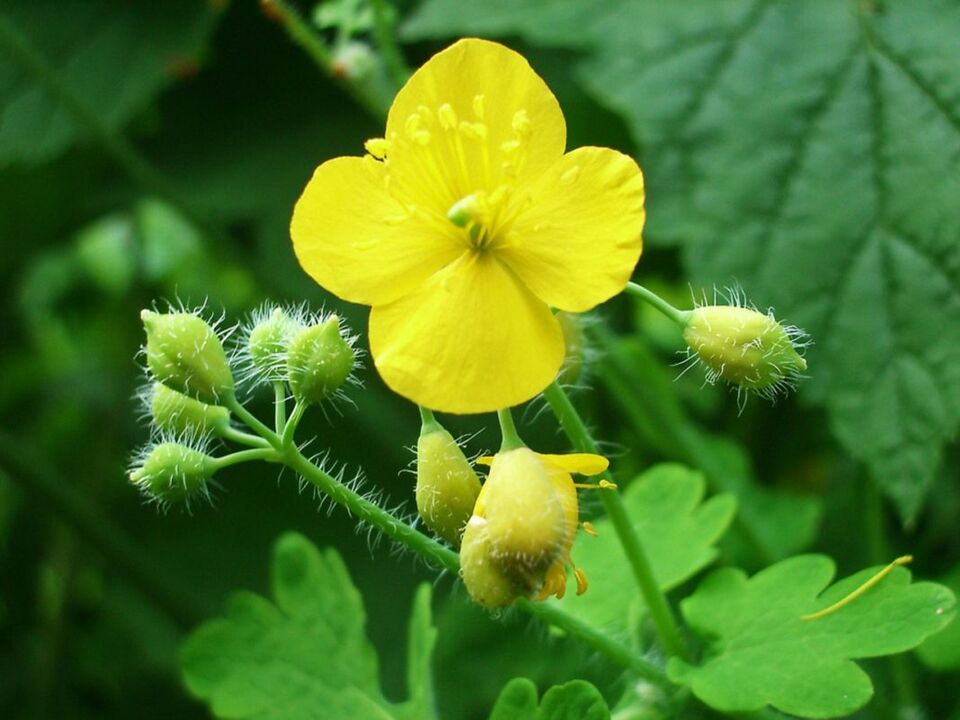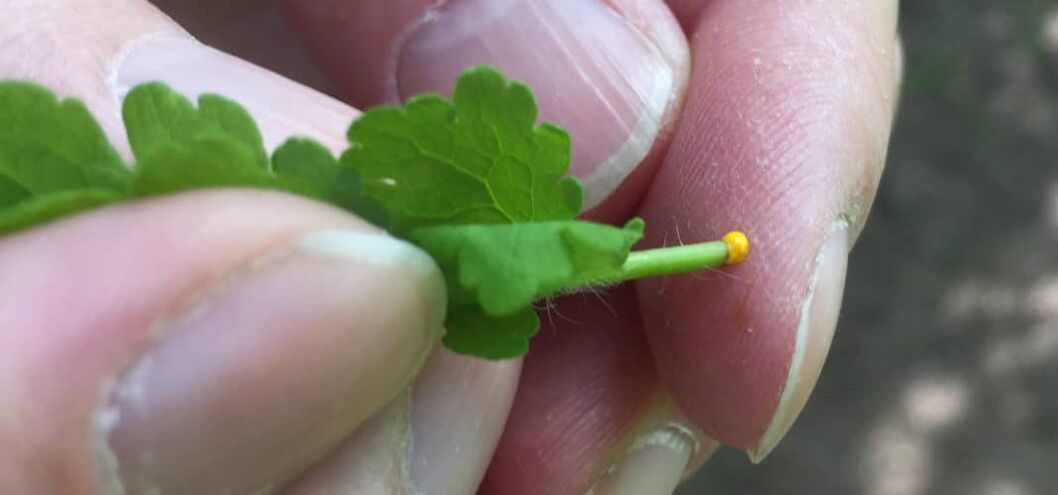Perennial celandine is used in folk medicine mainly for the yellow milk juice. In Europe, Asia and North America, the plant is located near settlements. With the introduction of synthetic drugs, celandine is increasingly forgotten, for which it is often called a weed. Previously, the medicinal plant was prescribed to combat warts and skin diseases. Clinical efficacy has been proven in two controlled studies. Celandine from papillomas is applied in the form of an ointment or gel to problem areas of the skin.
The composition and useful properties of celandine for papillomavirus.
Celandine contains around 20 isoquinoline alkaloids, present mainly in milk juice. The concentration of alkaloids in the grass is from 0. 48 to 1. 04%, in the roots - up to 1. 95%.
Other chemical compounds in celandine from papillomas:
- organic acids (chelidonic, malic, citric, ferulic acids);
- derivatives of phenolic acids;
- saponins, large amounts of calcium salts and proteolytic enzymes;
- flavonoids;
- biogenic amines (including histamine, tyramine);
- traces of essential oil;
- carotenes;
- vitamin C.
Glycogen is a storage substance in celandine. The seeds contain 40-60% vegetable oils. The plant smells bad and has a bitter taste. A strong odor can cause sneezing, coughing and even vomiting in sensitive people.
Initially, celandine was found in the warm and temperate regions of Europe and Asia, as well as in the Mediterranean, including North Africa. It was brought to North America by colonists who used it as a remedy for skin diseases. Celandine is a typical weedy plant, that is, it grows on rubble, debris, patio squares, verges and on hedges, walls, fences, fields and pastures.
Celandine derives its stems from a thick rhizome, which is orange inside (like a milky juice). The flowers consist of two sepals, four ovate golden-yellow petals, and numerous stamens. A 3-4 cm long capsule develops from the ovary. The black seeds have an oily appendage that the ants consume. They also distribute them around the area.
Celandine is used to treat spasms in the bile ducts and the gastrointestinal tract. It has not been finally proven whether celandine can treat warts, as traditional medicine says. The stems, leaves and flowers of celandine contain up to 1% alkaloids: chelidonine, coptisine and sanguinarine.
According to studies, the medicinal plant has a predominantly anticonvulsant and choleretic effect. Therefore, its use in spasmodic disorders of the bile ducts and the gastrointestinal tract is medically proven.
Celandine also has mild analgesic, cell division inhibitory, and antiviral effects. The last two effects may explain the long-term use of celandine against warts (caused by viruses).
In medicine, celandine is used, collected during flowering (only above-ground parts of the plant). It is recommended to use only finished preparations prepared with a standardized content of alkaloids. The reason is that the plant parts themselves contain an unclear amount of alkaloids. Excess plant matter damages the liver.
Almost all parts of celandine contain alkaloids. The stem contains 0. 1 to 1% alkaloids, depending on its origin and drying conditions. More than 30 different benzylisoquinoline derivatives (such as benzophenatridine, protoberberine, and protopine) have been identified in laboratory studies. Coptisine is the predominant alkaloid, accounting for up to 90%. Chelidonine is the main alkaloid of the roots. Other alkaloids in herbs and roots include berberine, chelerythrine, sparteine, helidoxanthine, and sanguinarine. In autumn, the chemicals concentrate in the root, which becomes highly toxic.
Various plant acids (chelidonic acid, citric acid, malic acid, and caffeic acid) are found in small amounts. Celandine is not rich in flavonoids. The orange-yellow color of milk juice is due to carotenoids and some alkaloids such as berberine.

Celandine has an antispasmodic effect on the upper digestive tract and stimulates the flow of bile. The antispasmodic effect is now considered proven. It was possible to test the choleretic effect only a few years ago. Additionally, antimicrobial, antiviral, and antitumor effects have been demonstrated for the extracts.
Methods of application in the treatment of pathology.
Celandine refers to folk remedies, so it is recommended to weigh the benefits and risks before use. A statement was issued advising against taking celandine preparations due to adverse effects on the liver.
Traditionally, fresh milk juice is used to treat warts, corneas, and calluses. Protein (proteolytic) and antiviral mechanisms are discussed as the main curative action. Currently, alkaloid extracts are widely used as standard drugs.
The main use of celandine is the treatment of skin diseases such as warts or calluses. For cramps in the upper digestive tract, the herb was previously used as a tea or tincture.
Internal use of celandine is no longer recommended. Since the entire plant contains a high proportion of toxic alkaloids, especially in the roots, it causes poisoning. On the contrary, the poisonous effect of the ingredients is reduced in the dried herb. It must be said that the content of toxic components varies according to the place, the plant and the season. Each person has a different constitution and therefore differs in sensitivity to toxins. If the plant is used externally, in some cases it can irritate the skin or cause allergies.
Pharmaceutical preparations based on celandine from papillomas.
Finished products containing celandine are available in the form of capsules, dragees, tablets and drops. Papilloma celandine is recommended to be used according to the instructions on the appropriate packaging or as recommended by the doctor. Traditionally, the milky juice of a medicinal plant or celandine tincture is applied to warts to remove them. How exactly to use the drug from papillomas, the doctor will tell.
Since the late 20th century, there have been reports of acute liver damage in patients treated with celandine preparations. Laboratory tests confirmed the high sensitivity of human hepatocytes to the alkaloids contained in celandine. As a result, preparations based on celandine are currently withdrawn from pharmacies. According to the European Medical Agency of 2010, the benefits of the use of medicines do not balance the risks to the health of patients.
Folk recipes based on celandine for HPV.
Not everyone knows how to use celandine correctly. Due to its toxic properties, treatment with a plant can only be carried out under the supervision of a doctor. The maximum daily dose is 12-30 mg of alkaloids, that is, 2-5 g of dried herb. When treating warts, it is recommended to treat warts with milk juice several times a day, trying not to cause blisters on healthy skin. Care must be taken that this juice does not come into contact with the eyes, as it causes a strong burning sensation. Wraps with milk juice are useful in the treatment of skin mycoses and difficult-to-heal wounds.
Decoctions, infusions and capsules
With menstrual problems, human papillomavirus and stomach cramps, celandine tea or capsules can help. In this case, an antispasmodic property is manifested. However, internal use is not recommended as the ingredients may be toxic. At too high a dose and long-term use increases the risk of developing gastrointestinal disorders.
Diluted tea and diluted tincture can be used externally for skin conditions: eczema, wart, or acne. It is recommended to pour 200 ml of boiling water over a teaspoon and let stand for 10 minutes. Then moisten a cloth with tea and apply to the affected area as a compress.
Oil and milk solutions
For the treatment of warts and corns, celandine milk is used due to anti-inflammatory alkaloids. It is recommended to cut several stems of celandine and apply the oozing yellow juice directly to the affected area 2-3 times a day for several weeks. The juice should only be applied to diseased tissue due to its irritating effect.

You can also make a tincture of the flowering herb or root and use it as a milky juice. Celandine tincture is available at health food stores. Since the tincture is not as strong as the juice, the duration of use is increased.
Side effects and contraindications
In rare cases, gastrointestinal discomfort occurs. Some patients have developed impaired liver function and jaundice with prolonged use of celandine. This may be due to alkaloid overdose or misuse (for example, severe inflammation of the liver or bile ducts). An overdose of celandine can also cause abdominal pain, intestinal colic, and blood in the urine.
Isoquinoline alkaloids are responsible for the toxic effects. Symptoms of poisoning include pain and burning in the mouth, salivation, diarrhea, and coughing up blood. In severe cases, dizziness, altered consciousness (including deep coma), drop in blood pressure, and tachycardia occur. Cases of fatal poisoning (in children) have been reported. Celandine juice can also cause skin irritation (burning, swelling, ulceration) and conjunctivitis (burning, watery eyes). Poisoning of animals does not usually occur because they avoid celandine due to the unpleasant smell and taste.
It is necessary to follow the dosage and duration of use indicated in the package insert or obtained from a doctor. Without interruption, celandine should be used for a maximum of four weeks.
Celandine should not be used in existing or past liver disease, gallstones, inflammation of the biliary tract, obstruction of the bile ducts, or liver damage. Also, pregnant women, lactating women and children under 12 years of age should refrain from using celandine.
If signs of liver damage appear during treatment (eg, yellowing of the skin or eyes, dark urine, upper abdominal pain, nausea, loss of appetite), treatment should be stopped immediately and medical advice should be sought. to a doctor.
Preparations with celandine can not be used for peptic ulcer, glaucoma and acute catarrh of the gastrointestinal tract. With prolonged use of celandine alkaloids, there is a risk of developing glaucoma.























